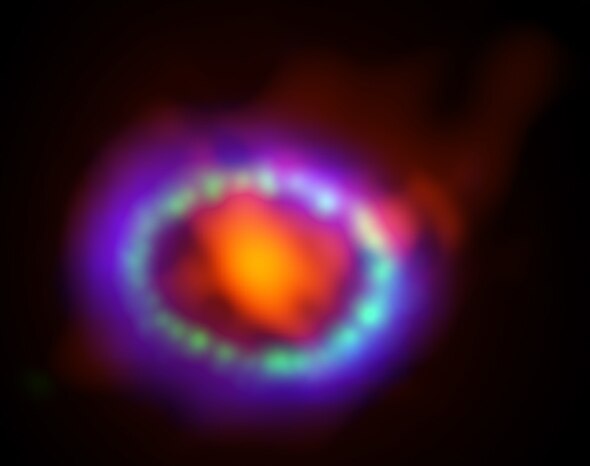Create a free profile to get unlimited access to exclusive videos, sweepstakes, and more!
The Shocking Dust of an Exploding Star

The Universe is a lot like the floor under your refrigerator: It has a lot of dust, and no oneâs really sure where it all comes from.
In this case, by dust I mean long, complex chains of molecules that are more like soot than anything else. Itâs seen everywhere in the Universe and is a major component of galaxies and gas clouds. It's also a contributing factor to the formation of stars and planets. Itâs a critical piece of the puzzle when we try to figure out whatâs going on out there in the Universe, and since thereâs so much of it itâs clearly pretty easy to make. The problem has been figuring out what makes it. We know that some is made when stars are born, and more when some stars die, but itâs been suspected for a long time that lots of dust (and the majority of it seen in very distant galaxies) is made when stars explode, but until recently there wasnât a lot of direct evidence for it.
That all changed a few years ago, when the Crab Nebula, the expanding remnant of a nearby exploded star, was seen to be loaded with dust. And now a second dust-formation site has been seen, and it turns out to be in an old friend: Supernova 1987A.
87A, as those of us in the know call it, was a blue supergiant star that exploded.* Located more than 160,000 light years away in a companion galaxy to the Milky Way, the light of the catastrophic explosion reached Earth in February 1987. It was the closest such supernova seen in four centuries. Over time, the region around the star was lit up by the fierce blast of light from the explosion, and it was found to be complex. Before it exploded, the star threw off huge amounts of gas, including a thick, dense, clumpy ring more than a light year across.
New observations using the Atacama Large Millimeter/submillimeter Array (ALMA) have revealed that after its death, the star was still busily sculpting its environment: It created a huge amount of dust, equal to about a quarter of the mass of the Sun! The dust is located in the center of the ejected material from the explosion, inside the thick ring.
While this isnât the first time dust has been seen in a supernova, this observation is important because the environment is pristine; the Crab, for example (which created about the same amount of dust as 87A), has had its material mixed in with the stuff already floating in between the stars, confusing things a bit. With 87A, we have a nice, clean lab sampleâin part because the expanding debris was so young.
So now that weâve seen the dust, the next question is, will it survive? The physics are somewhat complicated, but shock waves generated by the vast energies of the exploding star are ricocheting off material around the dust. These shock waves may be strong enough to blast the dust molecules apart, destroying them. This is important to know! Letâs say that for some reason, all the dust is destroyed in the next few years by these sonic booms. If thatâs the case, weâre back to square one: We see lots of dust in the Universe, and if itâs not coming from exploding stars (because they destroy it soon after making it) then we still donât know where the dust comes from. In reality, itâs likely only some of the dust made by the supernova will get zapped, and quite a lot will survive to spread out into space. But what fraction? A third, half, more? By studying 87A weâll be able to better understand the relative contributions of the various sources of dust in the Universe.
Follow-up observations by ALMA over the next few years should prove most interesting. Until then, stay tuned.
And as for the dust under your refrigerator? Youâre on your own there.
* I studied Supernova 1987A with Hubble for my Ph.D. and have written about it many times. If youâre interested, here are my articles about its discovery, the explosion itself, the gas seen around it, the ring in particular, how the explosion is interacting with ring, and what lies in the future for this object.


























